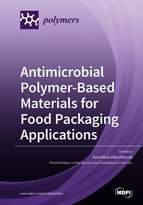Antimicrobial Polymer-Based Materials for Food Packaging Applications
A special issue of Polymers (ISSN 2073-4360).
Deadline for manuscript submissions: closed (15 August 2019) | Viewed by 77419
Special Issue Editor
Interests: nanomaterials; polymers; nanocomposites; inorganic nanoparticles; antibacterial agents; surfactants; interphases
Special Issues, Collections and Topics in MDPI journals
Special Issue Information
Dear Colleagues,
Antimicrobial packaging has recently attracted a great deal of interest from the food industry due to the boost in consumer demand for minimally-processed, preservative-free products. Antimicrobial polymeric packaging systems can be considered an emerging technology that could have an important impact on shelf life extension and food safety. Novel polymeric-based packaging materials are continually being developed.
Although the aim of these new materials is to improve packaged food quality and safety, the toxicological effects derived from their potential migration from the polymer structures is still under consideration. This Special Issue is planned to bring together a number of original papers and reviews covering (but not restricted to) the following topics:
- polymer nanocomposites with improved packaging properties
- biopolymers for active/bioactive/sensing applications;
- Mechanisms of action;
- Antimicrobial polymeric food packaging systems;
- Adverse effects of antimicrobial polymeric materials;
- igration/toxicological studies involving biopolymers and its nanocomposites.
- Future perspectives for antimicrobial polymeric nanomaterials
Guest Editor
Manuscript Submission Information
Manuscripts should be submitted online at www.mdpi.com by registering and logging in to this website. Once you are registered, click here to go to the submission form. Manuscripts can be submitted until the deadline. All submissions that pass pre-check are peer-reviewed. Accepted papers will be published continuously in the journal (as soon as accepted) and will be listed together on the special issue website. Research articles, review articles as well as short communications are invited. For planned papers, a title and short abstract (about 100 words) can be sent to the Editorial Office for announcement on this website.
Submitted manuscripts should not have been published previously, nor be under consideration for publication elsewhere (except conference proceedings papers). All manuscripts are thoroughly refereed through a single-blind peer-review process. A guide for authors and other relevant information for submission of manuscripts is available on the Instructions for Authors page. Polymers is an international peer-reviewed open access semimonthly journal published by MDPI.
Please visit the Instructions for Authors page before submitting a manuscript. The Article Processing Charge (APC) for publication in this open access journal is 2700 CHF (Swiss Francs). Submitted papers should be well formatted and use good English. Authors may use MDPI's English editing service prior to publication or during author revisions.
Keywords
- antimicrobial polymers
- food packaging
- migration
- barrier biocomposites and bioactive packaging







